Your essential guide to improving SEO for your landing pages
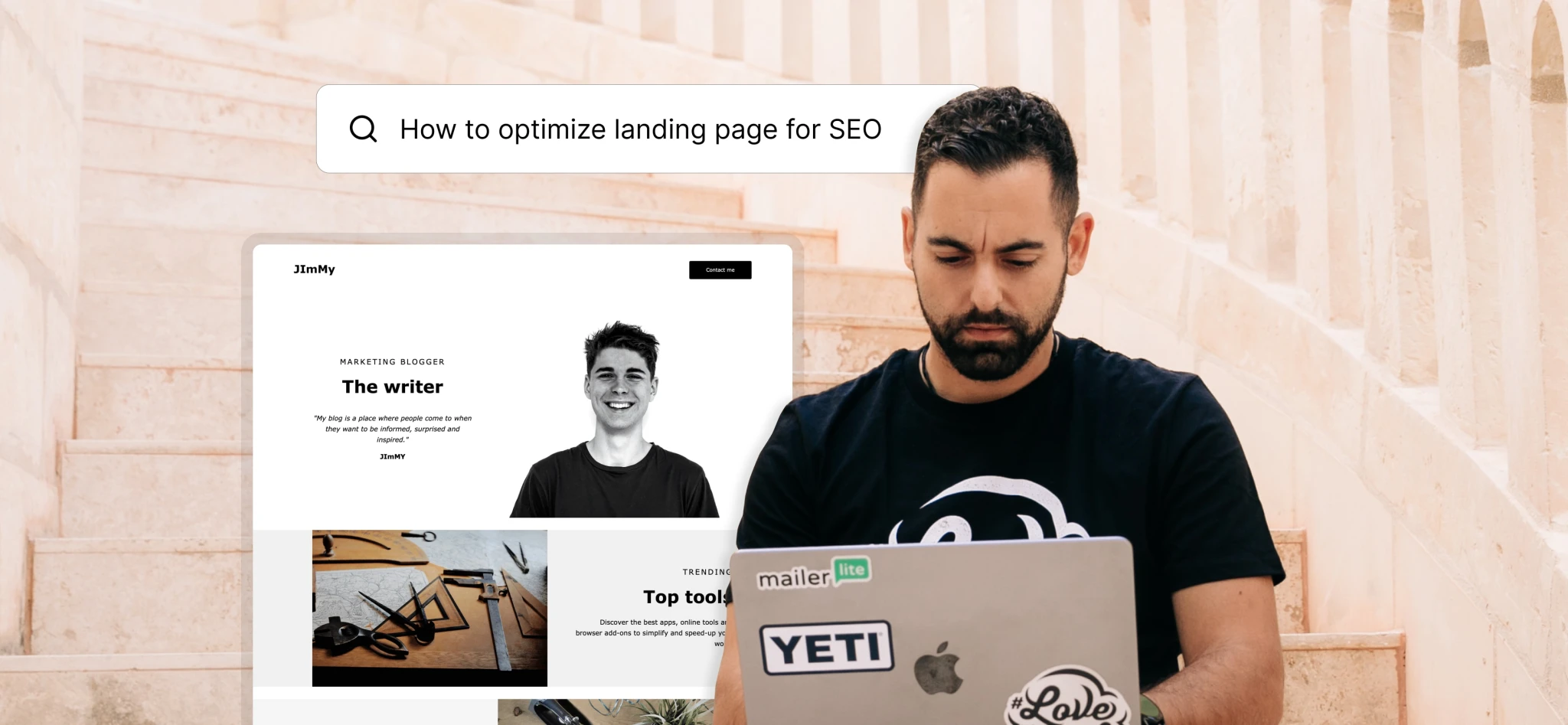 Support team member, Christos.
Support team member, Christos.
Everyone applies SEO (Search Engine Optimization) principles to their websites. But, did you know that you can optimize your landing pages for search as well?
SEO increases a website’s organic search traffic. Since it’s unpaid traffic, it’s one of the cheapest ways to attract your target audience. This makes landing page SEO a cost-effective strategy for bringing traffic to the pages that are meant to convert, potentially resulting in an overall lower CPC (Cost Per Conversion).
So when someone uses a search engine like Google to find something, you want to be there with the answer or solution.
If your landing page answers their question, they will reward you by becoming a subscriber or customer.
In this article, we’ll share the best SEO practices for landing page optimization that are quick to implement and will make a big impact on your organic traffic and lead generation.
What is SEO?
Search Engine Optimization (SEO) is the practice of optimizing your website and landing pages to help them rank in the organic results of search engines.
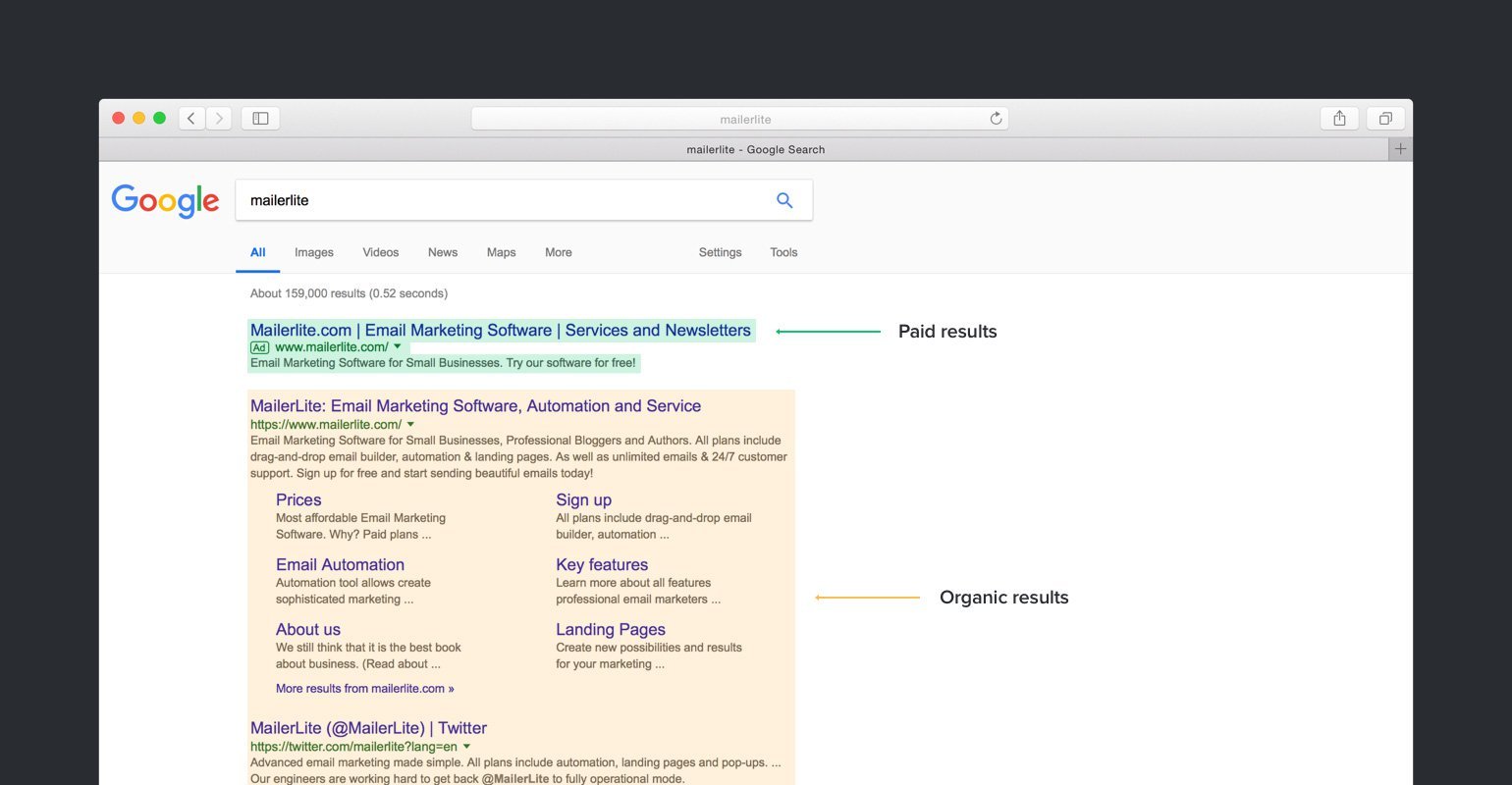
Why it’s important to optimize your landing pages for search engines
Optimizing your landing pages for search engines increases the chances that they will rank higher in the search results for relevant queries.
Ranking higher in the search results will bring in more traffic as people searching for those queries are more likely to find your page.
SEO can also increase your Google Ads Quality Score, which can result in more effective paid ads campaigns.
Should I do PPC or SEO for my landing page?
SEO and PPC (Pay-Per-Click) are not mutually exclusive and many businesses employ and benefit from using both. Promoting your landing page with PPC will start bringing in traffic right away while working on an SEO strategy should be done to generate traffic on a long-term basis.
That said if you’re strapped for time or resources, choosing whether to focus on SEO or PPC depends on multiple factors. Here are some of the key considerations:
Budget: PPC requires an ongoing budget to generate traffic
Time scale: SEO takes time to work. If you need traffic ASAP, it’s not a good strategy
Competitiveness: Competitive search terms are much harder to rank for with SEO unless you already have an authoritative website
Free SEO tools to help optimize your landing page
There are many tools you can use to optimize your landing pages. If you don't have a large budget, consider some of these free SEO tools.
Google autocomplete and related searches
Google Keyword Planner
We’ll go through how each of these tools is used in the sections below.
How to create SEO-friendly landing pages
SEO doesn’t need to be complicated. Making a few tweaks can have a big impact on your results.
The main steps to optimize your landing pages for SEO can be split into the following categories:
On-page optimization
Off-page optimization
Technical SEO
Results and analysis
Let’s take a deeper look at each.
On-page optimization
Choose your keywords
The first step of SEO is to choose the keywords you want to optimize your landing page for via keyword analysis. The purpose of keyword analysis is to understand potential visitors and their behavior, the possible volume of traffic, and competition. Ask yourself the following questions when analyzing keywords:
How are potential visitors searching for your product or service?
How do you rank against your competition for targeted keywords?
How much potential does your landing page or website have for organic traffic?
Can your landing page compete with the current competition?
Here’s how we conduct a keyword analysis
Step 1: Create a list of keywords based on how people search for your product or service.
If it’s a very unique product or service, you can ask people what phrases they would use to search for it
Check Google for suggested and related searches for your main keywords
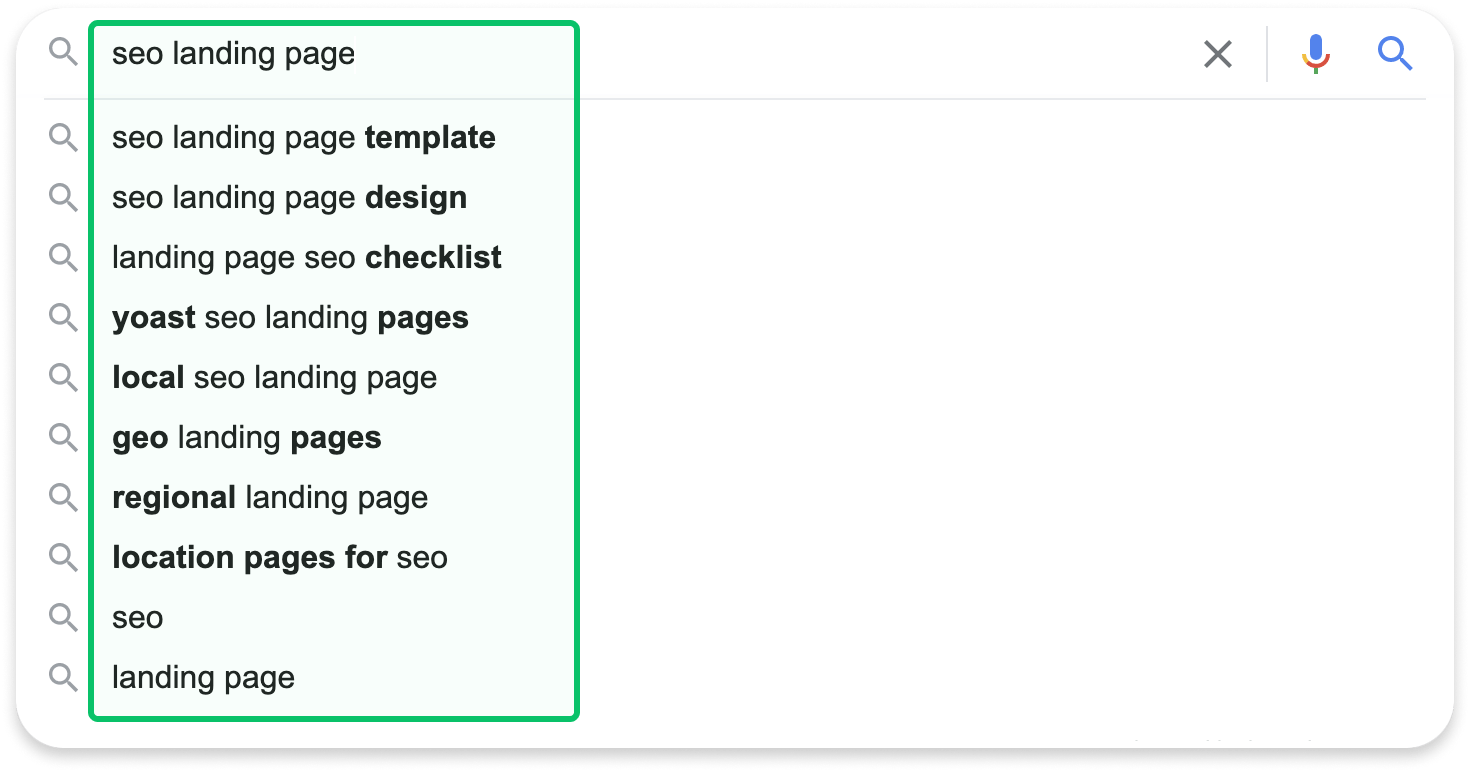
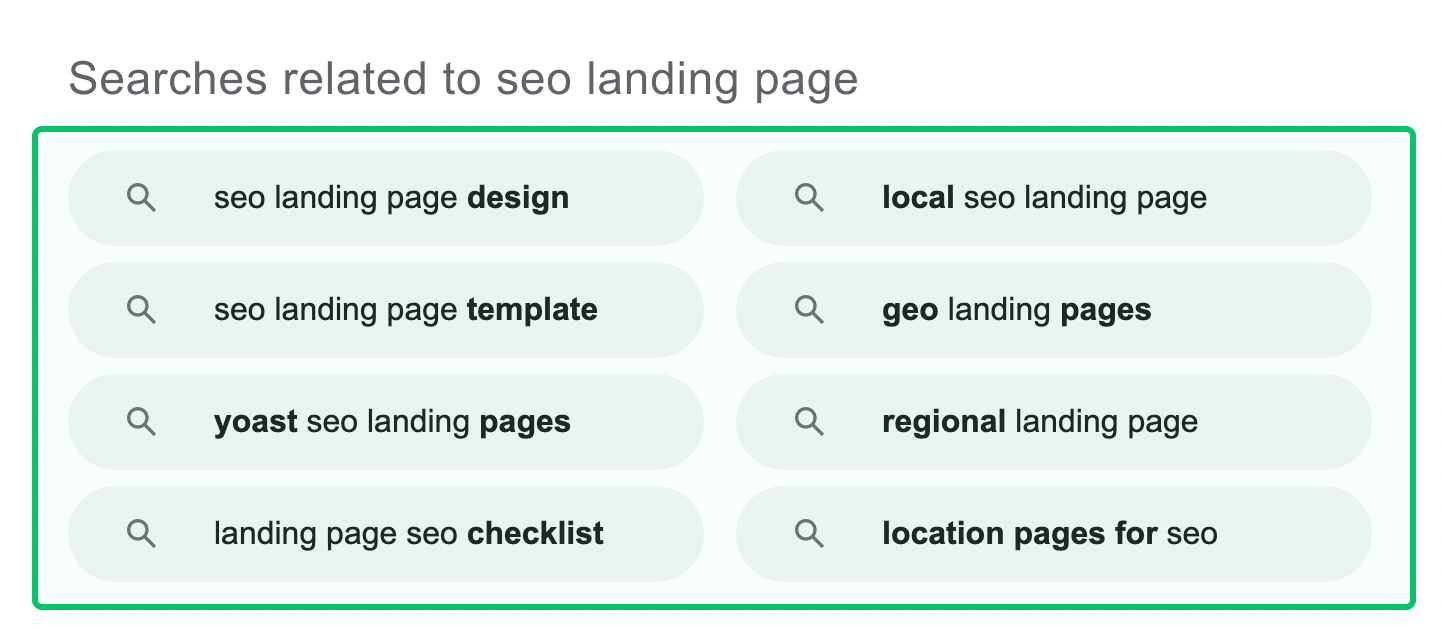
Check the keywords that your competitors use. Apps like SEMrush (free trial for 7 days) or Ahrefs help you analyze keywords and give you deeper insights into your competitors. You can also use them to track your and your competitor's rankings and visibility
For additional keyword ideas, you can use a free tool like KeywordSheeter. Just enter your main keyword and get a big list of related keywords. You can also check out this Ahref’s article for even more free tools to analyze how your competitors rank for each keyword compared to your pages
Step 2: If your website has several pages, group the keywords by your website categories. This makes it easier to analyze. For landing pages, you should focus on 1 offer and one group of semantically related keywords.
Step 3: Once you have your keyword list, analyze how your competitors are ranking for each keyword versus how your landing pages perform.
Step 4: Now you need to identify the type of page that shows up for the search query so you can create a similar page.
Let's use the keyword “Nike running shoes” as an example. The majority of results are for categories of Nike running shoes and reviews of the best shoes, both with multiple selections.
Ranking a landing page that focuses on a specific pair of Nike running shoes will be nearly impossible for the query “Nike running shoes” because the searcher expects to see a big list of the various available options.
Step 5: Now prioritize your keywords based on their search volumes and competition. An important thing to consider is long-tail keywords. Some niches can be very competitive, with big players completely taking over search results.
This makes it nearly impossible for smaller players to rank. In this case, consider shifting your focus from highly competitive keywords that have a lot of searches to keywords that are more targeted and specific, have a smaller search volume, and are less competitive. These can still have very good conversion rates.
For example, instead of focusing on the keyword "landing page optimization" you could narrow it down to "landing page optimization for search engines". By performing keyword analysis, you will understand which long-tail keywords are being searched for and which of them can be incorporated into your optimization strategy.
Read more detailed instructions for keyword analysis in our guide to SEO basics for websites.
Optimizing your landing page content
The next step is to incorporate your keywords throughout your landing page. This is called page optimization.
The main keywords should be included in your:
Headings (H1, H2 and so on)
Body text
Anchor links
Image alt text
Metadata (page title, description, URL)
Social proof
You no longer need to be an HTML expert to build and optimize landing pages—this is easy to do with MailerLite’s landing page builder.
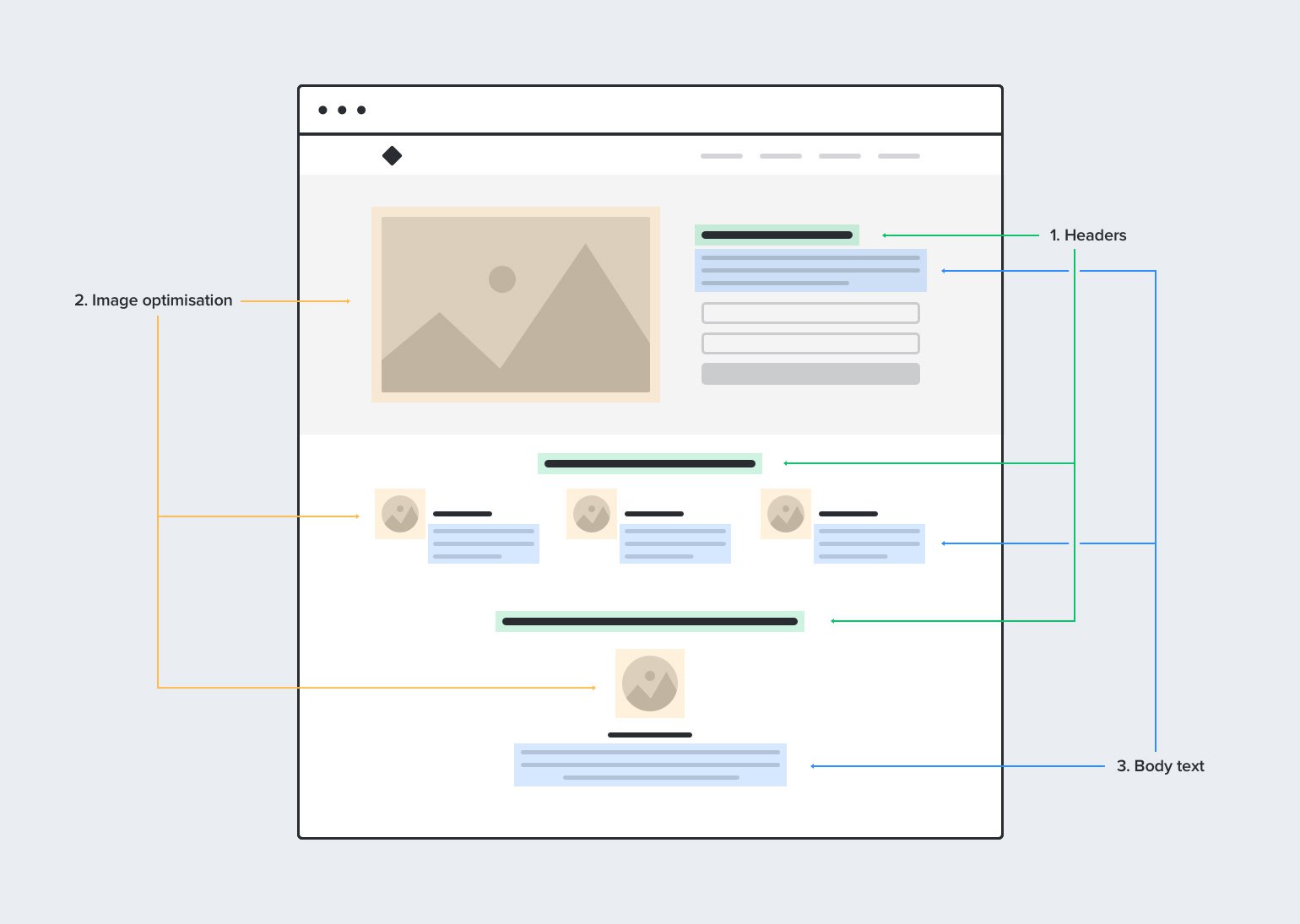
Optimize headings (H1, H2 and so on)
The main headline should clearly describe the content of your landing page and always include the most important keywords (try to insert them at the beginning of the heading).
It should always be marked with the header tag (e.g. <H1>) in the code. It is also recommended to use subheadings to break up the text. These headings should contain keywords that directly relate to the text below it.
Optimize body text
Body text should explain what you are offering in more detail. Instead of adding the same keyword multiple times, try using synonyms of your main keywords.
Google’s algorithm includes semantic search to better match search intent. So don’t try to stuff in as many keywords as possible just for the sake of it. To maintain high-quality content, the text has to be natural, easy to understand, and provide value to the reader.
Optimize anchor links
If your landing page is longer and more complex, add anchor links to help improve the user experience. This will allow the user to jump right to the section they care about. Also, search engines often create direct links to the anchored locations in search results.

Optimize Images (alt-text)
Search engines don't understand images. That’s why it’s important to add a text description (alt-text) to images to make them readable.
What’s more, using alt-text makes images more accessible for visually impaired visitors. Not only does it improve the user experience, but having good accessibility is also rewarded by Google.
There are 2 ways to add alt text to images:
The best option: Think of a unique name for each image that contains keywords from your analysis and a description of the image.
The fast option: Name the image with the title of your landing page. If you have more than one image, use the same description with numeration, e.g. “how to optimize landing pages to get more subscribers #1”, “how to optimize landing pages to get more subscribers #2”.
It is also considered good practice to include your focus keywords in the names of your image files. The image file name can be the same as the image alt-text.
To quickly check if an image has alt text, you can do the following in Chrome browser:
Right-click on the image > Click Inspect > Check if the image has the “alt” attribute.
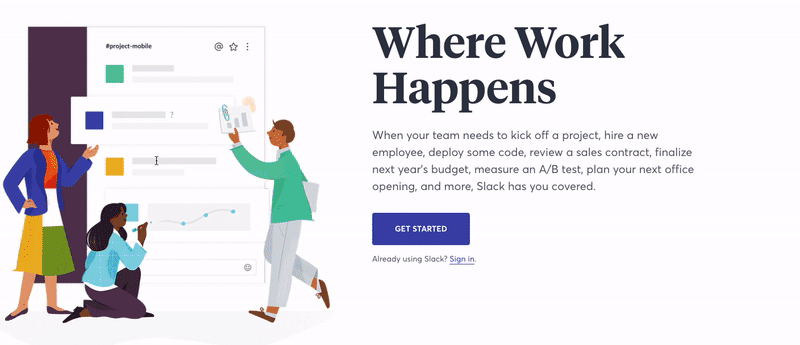
Content freshness
Your landing page content should be up to date and provide relevant information.
There are 2 reasons for this:
It helps to keep your visitors engaged. If your content is outdated, they’re likely to leave your page for the competition.
It signals to search engines that your website is active and reliable. They want to serve content that is up-to-date and relevant, so failing to keep content fresh can negatively impact your rankings.
How often should the content be updated?
Honestly... It depends.
If you are covering a topic that is always changing and evolving—for example, the smartphone industry—your article about the best new smartphones should be updated very often.
Look at when ranking articles were published to decide whether you should update your page. Simply enter your focus keyword and look at the timestamps on the search results. Based on that you can decide how often you should come back to your page and make content updates.
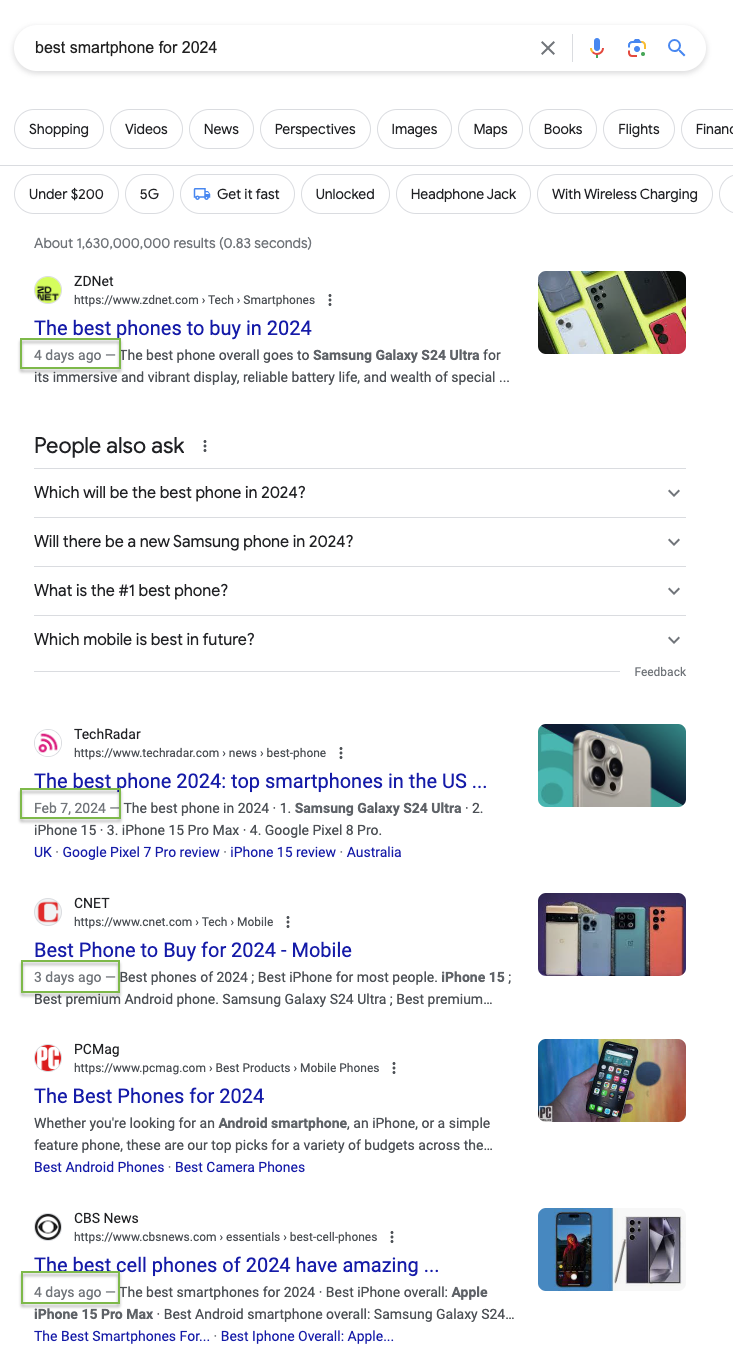
Optimizing SEO metadata
SEO metadata is the text that appears on search engine result pages (also called SERPs.) The metadata includes the title of the page, URL and meta description. These 3 elements have a direct impact on whether someone clicks on your result or moves on to another.
1. The meta title should be descriptive and explain the key benefits of your page and what people should expect from it.
Meta title length should be 50-60 characters
Place the most important keywords closer to the beginning of the meta title
When possible, use numbered lists (e.g. 5 tips for SEO) as they tend to increase CTR (Click-through Rate)
2. It's important to note that the meta title doesn't only impact the likelihood of a click but also directly affects how Google ranks your landing page. The URL (landing page address) should include your main keyword. It’s good practice to use similar text in both your URL and meta title.
3. A meta description is a more detailed explanation of your landing page. This is your opportunity to entice people to click by describing the value you provide, why you are better than your competitors, and why they should go to your page.
Meta description length should be up to 160 characters
Test the description as Google sometimes cuts the text
Include a CTA (Call To Action) at the end of the meta description
Your meta description has a huge impact on whether searchers decide to click on your landing page or not. By clearly describing the value proposition, you will drive people who need your product or service to your page.
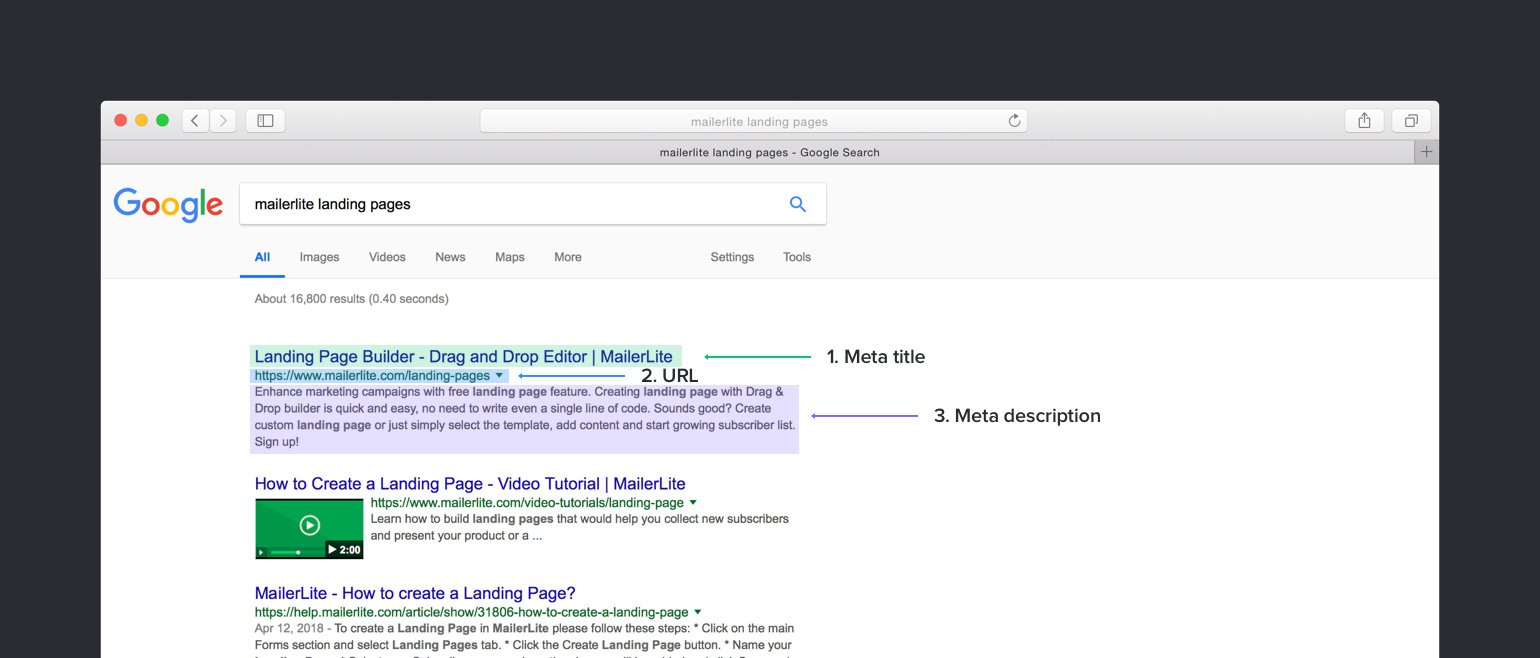
MailerLite’s landing page editor allows you to easily input your metadata descriptions.
Enter the landing page URL: It’s recommended to host the landing page under your domain so that it gains some of the domain’s SEO value.
Optional: Add a favicon (it's an icon visible on open tabs in your browser, usually your logo).
Enter the page title.
Optional: Enter a few page keywords (meta keywords) that describe your landing page (has no impact on Google).
Enter the page description (meta description).
Check the mark box so Google can crawl, index and rank your landing page.

Add internal links
Internal linking is the process of linking to and from relevant pages on your website. It helps search engines like Google to find and understand the pages. Plus, when done right it can pass page authority on, resulting in higher rankings.
In some cases, where you want the visitor to complete an action and you don’t want to lead them away to another page, you might want to avoid using internal links unless absolutely necessary. But if linking to other relevant pages can help gain more leads or make more sales, it’s a great way to make your landing page more valuable and improve SEO.
Here are some guidelines to follow to get the best results from your internal linking strategy:
1. Link to and from important, relevant pages: First of all, relevancy is key. If you’re trying to get people to sign up for a course on email marketing, there is little point in directing them to a page about social media.
Secondly, linking to the best-performing pages on your website will pass on page authority, helping with rankings. You can use an SEO tool like SEMrush to check the performance of your pages and decide which will be a good fit for your landing page.
2. Use unique anchor text that contains your keywords: Anchor text lets search engines know what the page you are linking to is about. Using generic anchor text is considered a bad practice and can affect your SEO rankings.
What’s more, linking to multiple pages with the same anchor text confuses search engines: they’ll think the pages are about the same topic. So, even if the pages are related, try to get more specific.
For example, let’s say you’re linking to 2 pages on your website for men’s and women’s Nike running shoes. Instead of using “Nike running shoes” as your anchor text, you should use “women’s Nike running shoes” and “men’s Nike running shoes”.
3. Add links above the fold: Including internal links toward the top of your page encourages more clicks, which results in a lower bounce rate and higher engagement.
These both signal to search engines that visitors are interested in the content on your landing page, and can give your page a boost in the rankings. Once again though, you should only include links that are relevant to your landing page goal, otherwise you could distract visitors from completing the intended action.
4. Open links in a new tab: Since the purpose of a landing page is usually to get someone to sign up for something, complete a purchase, or download a file, you don’t want them to leave the page if they click on a link. The best way to avoid this is to open any links in a new tab so that they can easily get back to the landing page.
Most website and landing page builders will have this option available, so all you have to do is enable it for the link. If you need to code it, you can use the target=”_blank” attribute in the <a> tag.
Example: <a href=”https://www.mailerlite.com/” target=”_blank”>MailerLite</a>
Use SEO-friendly URLs
Yes, URLs are just the address where your pages live but they also need to be optimized! Think about it, if your home address was hard to read or made of a random number sequence, the postal worker would probably have a hard time recognizing it.
Properly structured URLs serve a few purposes:
1. They can improve rankings as search engines can understand the relevancy of the page.
2. If they contain your keywords, they can work as anchor text where the URL is simply pasted as is, for example, on a forum or Reddit.
3. They are more user-friendly and trustworthy if they are easy to read and contain keywords relevant to what the user is looking for.
Here are the landing page URL best practices to keep in mind:
Use simple, descriptive words and preferably your page’s main keyword
Do not combine words—use hyphens (-) to separate them and not underscores (_)
If applicable, localize words to the language you are targeting
Use UTF-8 encoding where necessary. For example, for languages that do not use ASCII characters
Check out Google’s guide for URL structure best practices.
Off-page SEO
Link building
Getting backlinks (links to your web page from other websites) is one of the most important off-site ranking factors search engines use. Backlinks are like votes for your website—the more high-quality and relevant websites that link to your landing page the better results you can expect.
The rule "quality over quantity" is very true it comes to backlinks. One link from an authoritative and relevant website will have way more weight than a few links from a low-quality site. In fact, links from a very low-quality website may even hurt your results.
Here are a few easy ways you can earn backlinks:
Ask for links from your contacts. Maybe you participated in an event where a link to your page would be useful or perhaps you gave an interview to a blogger. Just ask for the link where appropriate
Use brand mentions tools like Brand24 to see when your brand is mentioned online. If you find that a website has mentioned your brand but didn’t link to your landing page, you can reach out and request that they add it. You can also use Brand24 to get notifications when your competitors are mentioned and try to win the link from the same source too
Reach out to niche websites or blogs that may find your content useful and ask them to link to your page
Share your content or blog posts in engaged forums with relevant discussions that add value
Check where your competitors have backlinks and see if there is potential for you to get one too. Previously mentioned tools like SEMrush and Ahrefs can help you with competitor backlink analysis
There are many different tactics depending on your content and business. For more detailed link-building ideas you can use this excellent resource.
Social sharing
Although links from social media won’t give your page a direct boost, you can use these sites to amplify your content and increase brand awareness. To help with this, you should make your content easily shareable on popular social media channels by adding the relevant icons for sharing.
This can also drive additional traffic to your website, signaling to search engines that your content is gaining traction.
Influencer outreach
Again, links from social media or YouTube won’t directly impact your SEO. However, if your product or service is promoted by influencers with large followings, they can drive a huge amount of traffic to your landing page. Even better, if they have a website or blog and link to your page, it’s likely to pass on significant page authority.
You shouldn’t reach out to any and all influencers—the best influencer campaigns are those where brands collaborate with highly relevant, niche creators with a very specific audience.
Identify the influencers who are relevant to your product or service and have an audience that fits your target market.
Avoid immediately going in for the kill—instead, take some time to develop relationships with the influencers. They are faced with tons of outreach from brands, so if you want to stand out it’s important to engage with them first.
Create a strategy for communication and be consistent. Think about the best time for outreach, how and when you’re going to follow up. And spend the time to personalize the communication for each influencer. It’s very easy to tell when a message is copied and pasted template.
Think about how the collaboration will be mutually beneficial. Do you have a budget to spend on influencer marketing? Are you restricted to gifting or exchanging exposure for exposure, a link for a link?
Technical SEO
Landing page loading speed
The lower the load time, the better. Try to aim for a load speed under 3 seconds. Every additional second may badly hurt your bounce rates and overall user experience. Some of the issues that can cause slower loading speeds:
Poorly optimized images
Bad coding practices
Hosting service or issues with servers
Unnecessary redirects
Too many plugins (especially for WordPress users)
Every page could have different issues that cause poor loading speed, so before going live with your website or landing page it is recommended to test it with a few different tools and see what can be improved.
You can run the tests with the official Google tool, Page Speed Insights, or with tools like WebPage Test and GTmetrix. You can also access your webpage loading speed in Google Analytics.
It is best to run a few tests as the results can vary depending on location, time and the tool you're using.
Mobile-friendliness
Make sure your page is responsive to different smartphones and tablets by checking various devices and resolutions. A mobile visitor should have an easy time navigating through the page, reading text and CTAs, and clicking on links and menu items.
If you are using MailerLite's landing pages all of that is already taken care of.
For testing whether the website or webpage is responsive on mobile devices, use the official Google tool. Google Search Console also provides additional information regarding website responsiveness.
Structured data
Structured data markup helps search engines to understand what's on a page by classifying page content. It’s important for SEO as it also allows your appearance in search results to contain rich snippets or rich results. This makes search results stand out more in the SERPs and thus makes them more engaging than those without.
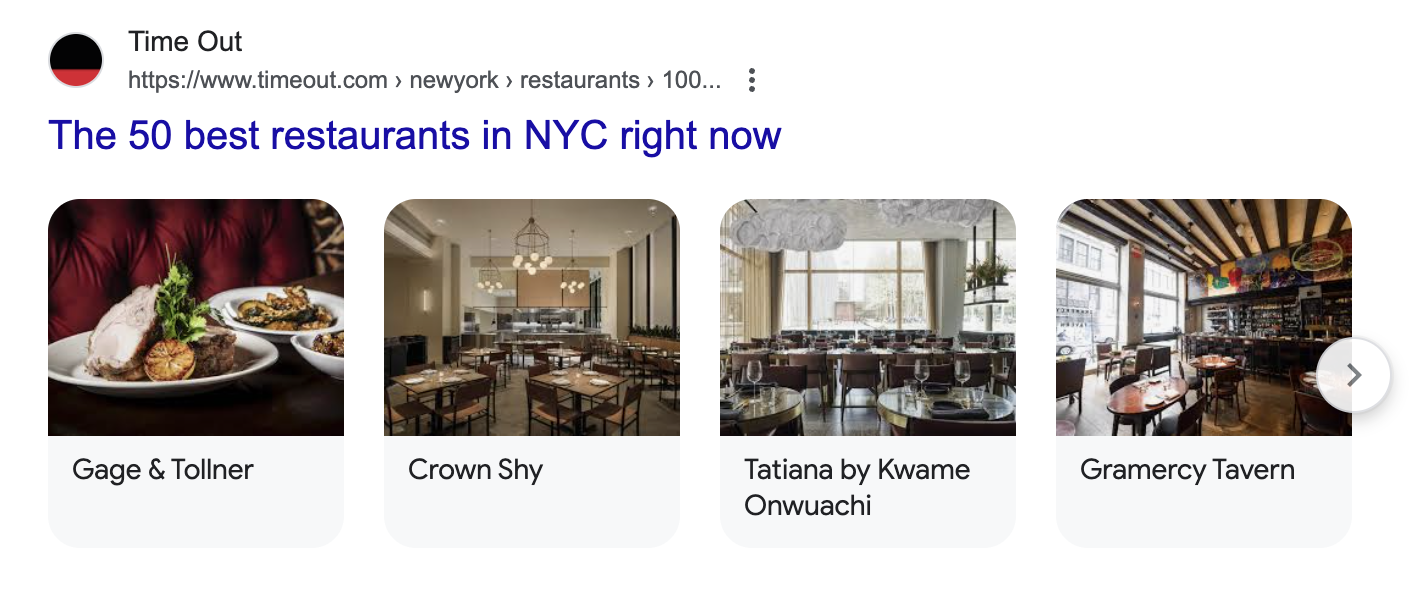
Adding structured data involves adding some data labels to your code. If you cannot edit your page’s code directly and are using a website builder or CMS, it may have some search engine options available that allow you to add structured data markup.
Check out this guide to getting started with structured data.
Make sure that your page is indexed
Once your landing page has been published, head to Google Search Console and submit it for indexing. You can do this by entering the URL in the URL inspection field and then clicking Request indexing. Check back in a day or so to see the status of the page and then head to Google to do a site query search: site:www.website.com/landing-page.
Tips for CRO
CRO (Conversion Rate Optimization) is the process of improving the effectiveness of a website, landing page, or digital marketing campaign to increase the percentage of visitors who take a desired action. This could be making a purchase, signing up for a newsletter, or filling out a form. A few ways you can improve your CRO include:
Add social proof
Positive reviews on your landing pages can fast-track the process of building trust with new customers.
Although it’s unlikely that your customers will use the keywords you are trying to rank for, testimonials that are semantically related to your business can boost your overall landing page SEO. Semantically related keywords are words or phrases that are related to each other conceptually.
Semantic keywords for “How to make the best pancakes” include:
Pancake recipe
How to make pancake mixture
Traditional pancake
Moreover, testimonials will add to the length of your copy which will further improve the landing page authority.
Include your Unique Value Proposition (UVP)
A UVP is a clear statement outlining the distinct benefit or advantage that your product, service, or brand offers to your customers or target audience. It communicates why the offering is different and better than competitors' offerings, and why customers should choose it over alternatives. It also highlights the specific problem it solves or the need it fulfills and how it is uniquely valuable in the marketplace.
A great UVP should be memorable and clear and easy to understand. It should include:
A catchy, attention-grabbing headline that highlights the main benefit
A brief description of your offering to further explain why it’s unique, solving the visitor’s problem, and better than competitors
Visual content such as an image or video that demonstrates the product or service and strengthens the message
Follow your UVP with your call-to-action so the visitor can quickly and easily become a lead or customer.
Results' analysis and adaptation
The last step of landing page optimization for search engines is to track your results. If you don’t measure performance, you’ll never know if it is properly optimized.
The most important things to track are your organic traffic and click-through rates. You can track these metrics using free tools like Google Analytics GA4 and Google Search Console.
To track your organic traffic and conversions using Google Analytics:
1. Navigate to Reports > Acquisition > User acquisition.
2. Select the date range.
3. In the filter at the top add a filter. Change the Dimension to First user default channel group, Match type to Exactly matches, and Value to Organic search. Click Apply.
3. Where the results are displayed, below the graph, click the + to add a new filter. Select the Landing page filter and, in the search bar, enter your landing page slug.
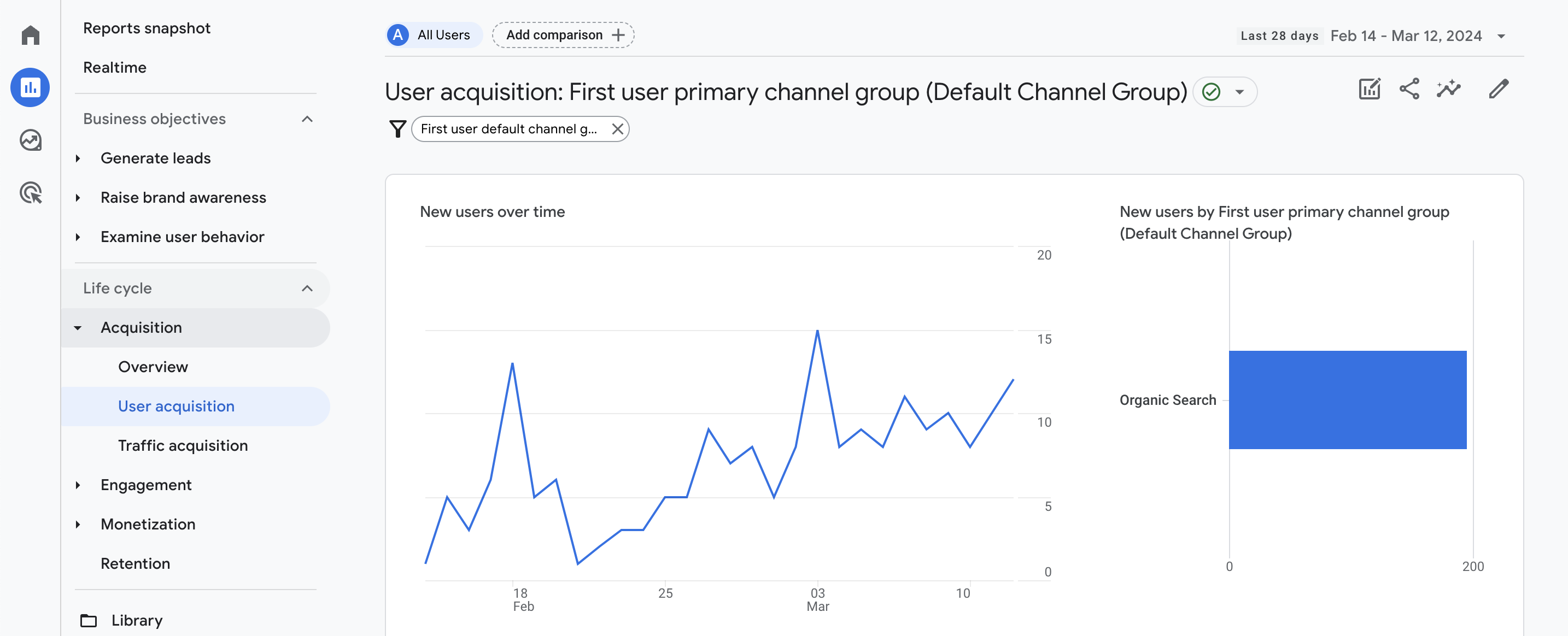
Check out this guide to learn how to set up analytics.
To track your keyword position and click-through rate using Google Search Console:
Go to Performance and filter your results by date range, pages, queries or other filters.
.png)
For more information, head to this guide on how to set up Google Search Console.
Depending on how your page is performing, you can make minor tweaks to improve organic traffic.
For example, if you see that the click-through rate on Google is dropping drastically, try making some changes to the metadata, such as your meta description. Or, if you have a high bounce rate on your landing page, change the headings or body text to better describe the premise of the page.
Remember, there is no set formula for success. A lot depends on your messaging and the behavior of your potential visitors. As you track results and optimize, you will learn more about your audience and improve results over time.
Examples of well-optimized SEO landing pages
Several customers have taken advantage of our landing page editor to optimize their pages. Here are a couple of examples to inspire you.
Edit Republic
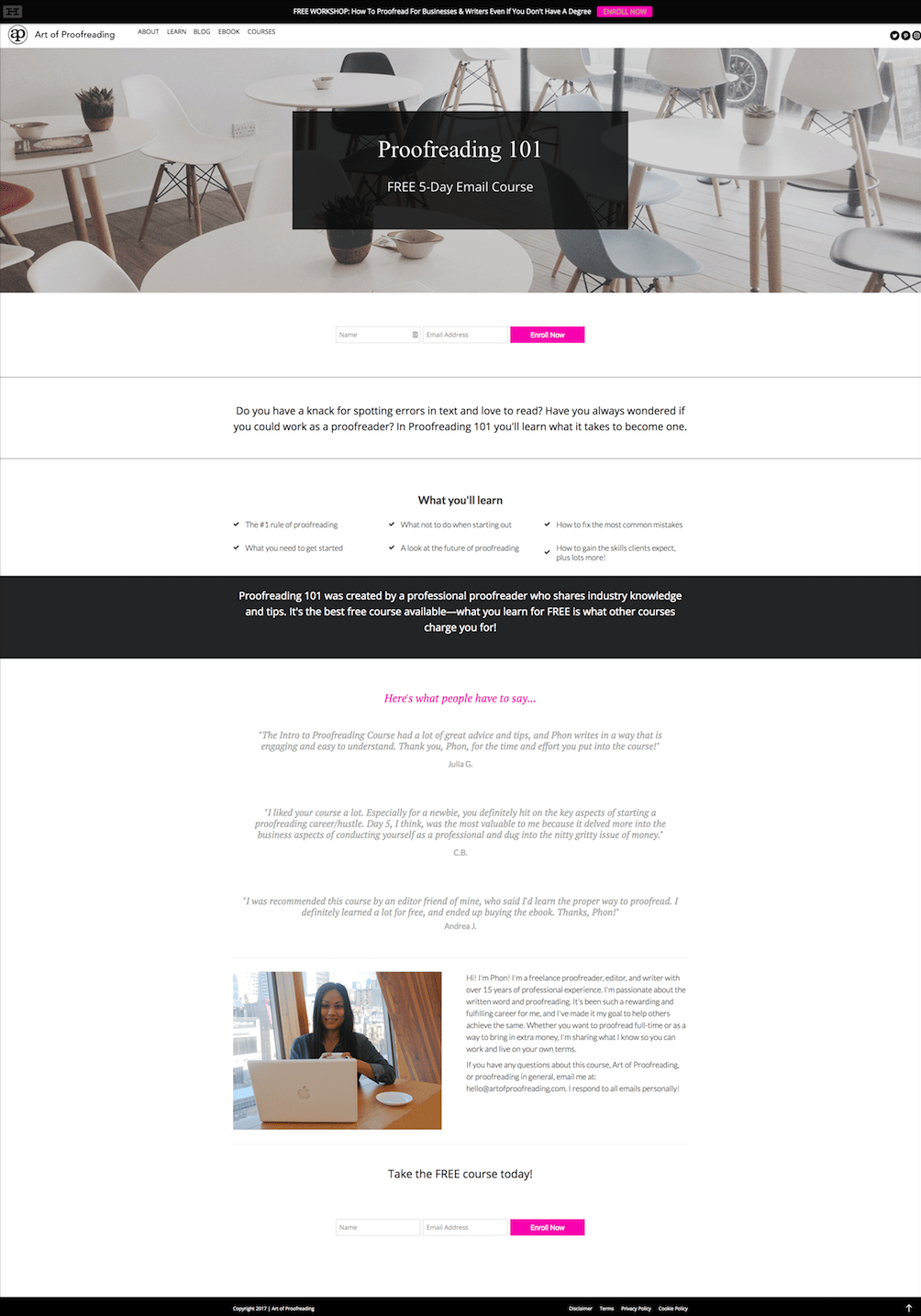
Pros:
Good usage of keywords
Image optimization
Text formatting (listings)
Good page title and URL
Cons:
Better optimization of headings (H1 is missing)
Only 1 image
Although Google is good at pulling out information from your page, the meta description should still be added.
Carhood

Pros:
Good use of keywords
Good use of headings
Optimized page title and URL
Cons:
Image alt text is missing
Meta description could be longer with a more detailed description
MailerLite

Pros:
Good amount of text on the page without being overwhelming
Good use of headings throughout
Use of FAQs to boost keyword usage
Optimized for mobile devices
Your Landing page SEO checklist
On-page SEO
✅ Conduct keyword analysis for landing pages
✅ Optimize landing page content
✅ Optimize headings (H1, H2 and so on)
✅ Optimize body text
✅ Optimize anchor links
✅ Optimize Images (alt-text)
✅ Keep content fresh
✅ Optimize SEO metadata
✅ Add internal links
✅ Optimize URL structure
Off-page SEO
✅ Develop a link building strategy
✅ Make social sharing easy for visitors
✅ Conduct influencer outreach and develop a strategy
Technical SEO
✅ Optimize landing page loading speed
✅ Ensure your landing page is mobile-friendly
✅ Add structured data
✅ Ensure the page is indexed
CRO and other tips
✅ Add social proof
✅ Add your UVP
Results' analysis and adaptation
✅ Track organic traffic and conversions using Google Analytics
✅ Track keyword position and click-through rate using Google Search Console
Other ways to optimize your landing pages
Beyond SEO, there are lots of other ways to optimize your landing pages for better conversions. Here are some ideas to get you started: 13 tips for an effective landing page.
Share your experiences with landing page optimization or ask us questions in the comments below!
Want to create landing pages with MailerLite for free?
TRY NOWEditor's note: This post was originally published in June, 2018 but has updated with fresh content and ideas.